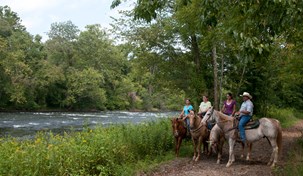While most rail-trails have a characteristic straight and level projection, some do have surprising twists, turns, and elevation gains as they follow old train routes that carried lumber or minerals out of mountainous wildernesses. Today, these more unusual rail-trails make for some terrific mountain biking.
Spanning 72 miles between Parkersburg and Wolf Summit, the North Bend Rail Trail offers some seriously stunning natural scenery coupled with several spectacular bridges and tunnels. In this remote wilderness, youre likely to have wildlife encounters, but there are also welcoming rural towns that dot the way when you need to rest and refuel.
This 28-mile, primarily gravel trail begins in Park City and heads north to Echo Reservoir. You’ll pedal along Silver Creek through a narrow volcanic canyon, then transition to wetlands and farms. Along the way, keep your eyes peeled for moose, fox, bald eagles, herons, deer, and other wildlife. The rail-trail also serves as a connector to several hundred miles single-track paths if you’re up for more adventure.
True to its name, the Cowboy Trail is a Wild West adventure. One of the country’s longest rail-trails, it stretches a continuous 198 miles between the Nebraska towns of Valentine and Norfolk, as well another 20 miles in a disconnected segment farther west between Gordon and Rushville. The crushed-gravel trail traverses native prairie lands, grass-covered dunes, and dozens of bridges, including a stunning crossing of the Niobrara River 150 feet above the water.
At 58 miles, the Northern Rail Trail is the longest rail-trail in New Hampshire and offers a variety of surface types along its impressive length, including dirt, grass, cinders, and crushed stone. Along the way, you’ll traverse the scenic Mascoma River Valley, wind through cool rock cuts, skirt around ponds, and see some historical remnants from the trail’s past as a railroad.
Upper Gold Camp Road charts a sinuous route through the Pike National Forest southwest of Colorado Springs. The high-elevation gravel and dirt trail offers spectacular views following the route of old mining trains. From east to west, the trail climbs at a gentle grade as it makes its way through the mountains and half a dozen tunnels.
This crushed-stone pathway travels 62 miles from Gaylord up to Mackinaw City at the tip of Michigan’s “Mitten.” The rail-trail offers a kaleidoscope of changing scenery, including rolling hills, agricultural lands, beautiful northern woods, and sparkling waterways. Thriving tourist towns at either end also provide the perfect place to prepare for departure or celebrate the adventure.
What is today the Route of the Hiawatha was also known as one of the most scenic stretches of railroad in the country. Today, the 15-mile gravel rail-trail offers a series of spectacular trestle bridges and tunnels, including the Taft Tunnel, which burrows 8,771 feet (1.6 miles) under the Bitterroot Mountains at the state line between Idaho and Montana.
At nearly 3,600 feet, Whitetop, part of the Blue Ridge range in southwestern Virginia, is the high point of the Virginia Creeper Trail and is thought to be the genesis of the Virginia Creeper nickname for the railroad. Trains (and bikes today) had to creep up the slope. This eastern side of the crushed-stone trail is heavily wooded. From Damascus (the midpoint of this trail, as well as a town on the Appalachian Trail) to Abingdon in the west, the trail becomes more open and pastoral.
This crushed-stone pathway runs through the heart of South Dakota’s Black Hills, connecting Deadwood with Edgemont. Along its 109-mile length, the rail-trail incorporates nearly 100 converted railroad bridges and four tunnels, and features a gradually changing landscape, from mountains and corridors of ponderosa pine to high mountain meadows and the open prairie.
Our list wouldn’t be complete without mentioning the longest rail-trail in America: Missouri’s Katy Trail. The 240-mile crushed-limestone pathway nearly traverses the state east-to-west, hugging the Missouri River for much of the way and retracing the journey of Lewis and Clark. Friendly towns, forested valleys, rolling farm fields, wetlands—you’ll find it all here.
Here, you’ll find some extraordinary rail-trails tucked away in quiet forests that offer colorful spectacles come fall...

Many rail-trails that wind through rural parts of the country can be explored on horseback. Here are some of our favorite equestrian trails...
"Virginia is for Lovers" is the tourism slogan for the state, but for outdoor enthusiasts, you could also easily say that "Virginia is for Trail Lovers."
 Your donation will help us to continue connecting more people to trails around the country.
Your donation will help us to continue connecting more people to trails around the country. Become an RTC member and wear your FREE T-Shirt with pride. Help defend and expand trails nationwide.
Become an RTC member and wear your FREE T-Shirt with pride. Help defend and expand trails nationwide. Get a FREE Rail Trails Guidebook when you become a Member with Rails-to-Trails Conservancy."
Get a FREE Rail Trails Guidebook when you become a Member with Rails-to-Trails Conservancy."